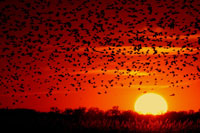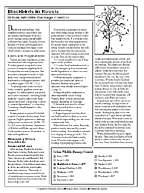Blackbirds
 Blackbirds and starlings often establish roosts in areas where they are unwelcome because of the economic damage and potential health problems they cause. Grackles, brown-headed cowbirds, red-winged blackbirds and starlings form large roosts which create a nuisance in urban areas.
Blackbirds and starlings often establish roosts in areas where they are unwelcome because of the economic damage and potential health problems they cause. Grackles, brown-headed cowbirds, red-winged blackbirds and starlings form large roosts which create a nuisance in urban areas.
Summer and fall roosts
After nesting, blackbirds and starlings begin forming flocks and roosts. Roosts are sometimes formed by late June, but most are established in July. Because flocks prefer deciduous trees, the prevalence of deciduous shade trees in urban and suburban areas makes these sites attractive. Thousands of blackbirds may occupy several blocks of suitable trees in summer roosts. Birds abandon deciduous tree roosts when the leaves drop in the fall.
Winter conifer roosts
Many blackbirds migrate south, but some sizable flocks of grackles, cowbirds and starlings remain in Kansas during the winter, especially in the southern counties. After leaf fall, flocks assemble in conifer plantations to take advantage of the protective cover of the closely spaced trees. Roosts are formed in late fall and may persist until March of the following year.
Blackbird Control
 Blackbirds in Roosts: Urban Wildlife Damage Control
Blackbirds in Roosts: Urban Wildlife Damage Control